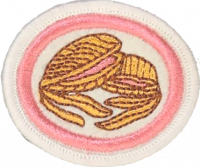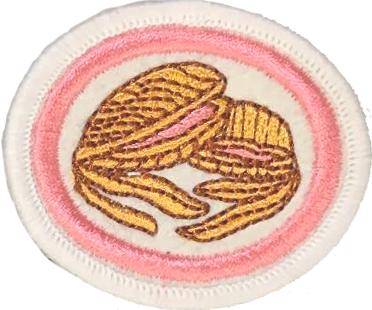Difference between revisions of "AY Honors/Land and Freshwater Mollusks/Answer Key/es"
(Updating to match new version of source page) |
(Created page with "Especialidades JA/Moluscos terrestres y de agua dulce/Respuestas") |
||
| Line 63: | Line 63: | ||
{{clear}} | {{clear}} | ||
| − | + | {{clear}} | |
| − | |||
| − | |||
<div lang="en" dir="ltr" class="mw-content-ltr"> | <div lang="en" dir="ltr" class="mw-content-ltr"> | ||
Revision as of 15:36, 11 April 2021
Nivel de destreza
Desconocido
Año
Desconocido
Version
29.12.2025
Autoridad de aprobación
División del Pacífico Sur
1
2
3
Prolific breeders, pulmonate land snails inseminate each other in pairs to internally fertilize their ova via a reproductive opening on one side of the body, near the front, through which the outer reproductive organs are extruded so that exchange of sperm can take place. Fertilization then occurs and the eggs develop. Each brood may consist of up to 100 eggs.
Garden snails bury their eggs in shallow topsoil primarily while the weather is warm and damp, usually 5 to 10 cm down, digging with their foot. Egg sizes differ between species, from a 3 mm diameter in the grove snail to a 6 mm diameter in the Giant African Land Snail. After 2 to 4 weeks of favorable weather, these eggs hatch and the young emerge. Snails may lay eggs as often as once a month.
The snail's shell develops while it is still an embryo; it is, however, very weak, and needs an immediate supply of calcium. Newly hatched snails obtain this by eating the egg from which they hatched. The cannibalization by baby snails of other eggs, even unhatched ones, has been recorded and is a problem in farming snails.
Promptly after they are finished ingesting their egg casings, they crawl upwards through the small tunnel in order to digest the egg. At this stage, the young are almost completely transparent and colorless. Their shell is usually slightly smaller than the egg they hatched from, but their length when out of their shell is slightly greater than the egg diameter. After a few weeks, the snails will begin to show their first tinge of color, usually slightly blue, before they turn their adult color. Roughly three months after they have hatched, they will look like miniature versions of their parents. They will continue to grow, usually for two to three years, until they reach adult size, although there have been confirmed recordings of snails growing amazingly fast - becoming even bigger than their parents in little more than a month.
4
Bivalves, (clams and mussels) are effective filter feeders and can have large effects on the water columns in which they occur. They remove plankton and organic particles from the water column and can significantly improve water quality and clarity.
Freshwater Mussels and clams have a foot that allows them to move around or anchor into the mud.
5
5a
The eggs of certain snail species are eaten in a fashion similar to the way caviar is eaten.
Note that snails are scavengers, not clean animals, and are not recommended as food for Pathfinders.
Pest control While most snails are considered agricultural pests, the decollate snail (Rumina decollata) will capture and eat garden snails, and therefore has sometimes been introduced as a biological pest control agent. However, this is not without problems, as the decollate snail is just as likely to attack and devour other gastropods that may represent a valuable part of the native fauna of the region.
Cosmetic skin creams derived from Helix aspersa snails are sold for use on wrinkles, scars, dry skin, and acne. A research study suggested that secretions produced under stress by Helix aspersa might facilitate regeneration of wounded tissue.
Snails are farm raised (Heliciculture) for food, snail slime, and for pest control purposes in some areas.
Symbolism Because of its slowness, the snail has traditionally been seen as a symbol of laziness. In Christian culture, it has been used as a symbol of the deadly sin of sloth. Psalms 58:8 uses snail slime as a metaphorical punishment. The terms "snail's pace" and "snail mail" suggest slowness.
Divination, with snails is an attempt to gain insight into a question or situation by way of an occultic, standardized process or ritual. Also not recommended for Pathfinders.
5b
Crop Damage: The same snails that some people raise or gather as food also are agricultural pests that cause considerable crop damage. Introduced slug and snail varieties tend to be worse pests than native species, probably due in part to the lack of natural controls. Snail pests attack crops ranging from leafy vegetables to fruits that grow near the ground, such as strawberries and tomatoes, to citrus fruits high up on trees.
The Federal Plant Pest Act defines a plant pest as "any living stage (including active and dormant forms) of insects, mites, nematodes, slugs, snails, protozoa, or other invertebrate animals, bacteria, fungi, other parasitic plants or reproductive parts thereof; viruses; or any organisms similar to or allied with any of the foregoing; or any infectious substances, which can directly or indirectly injure or cause disease or damage in or to any plants or parts thereof, or any processed, manufactured, or other products of plants..." The Animal and Plant Health Inspection Service (APHIS) categorizes giant African snails as a "quarantine significant plant pest." The United States does not allow live giant African snails into the country under any circumstances. It is illegal to own or to possess them. APHIS vigorously enforces this regulation and destroys or returns these snails to their country of origin.
Since large infestations of snails can do devastating damage, many states have quarantines against nursery products, and other products, from infested states. Further, it is illegal to import snails (or slugs) into the U.S. without permission from the Plant Protection and Quarantine Division (PPQ), Animal Plant Health and Inspection Service, U.S. Department of Agriculture. APHIS also oversees interstate transportation of snails. Anyone who plans to "import, release, or make interstate shipments of" snails, must complete APHIS's PPQ Form 526, Application and Permit to Move Live Plant Pests and Noxious Weeds. Submit the form to your State regulatory official. The state will process the request and make a recommendation to APHIS who will then make a decision.
Invasive Species and Ecosystem Damage: Accidental or deliberate introduction of various snail species into new territory has resulted in serious damage to some natural ecosystems.
Schistosomiasis (also known as bilharzia, bilharziosis or snail fever) is transmitted to humans via freshwater snail hosts. It is "second only to malaria as the most devastating parasitic disease in tropical countries. An estimated 200 million people in 74 countries are infected with the disease — 100 million in Africa alone." The worm is caught from contact with water that includes infested snails. The worms may infect the urinary tract or intestines. Symptoms may include abdominal pain, diarrhea, bloody stool, or blood in the urine. In those who have been infected a long time, liver damage, kidney failure, infertility, or bladder cancer may occur. In children it may cause poor growth and learning difficulty. It kills up to 200,000 people a year. Improving access to clean water and reducing the snail population reduces infection rates, as does the drug Praziquantel.
6
6a
Snails can be found in a very wide range of environments, including ditches, deserts, and the abyssal depths of the sea. Although land snails may be more familiar to people, marine snails constitute the majority of snail species, and have much greater diversity and a greater biomass. Numerous kinds of snail can also be found in fresh water. Many land snails are valuable because they can feed on a wide range of agricultural wastes, such as shed leaves in banana plantations. They are also considered pests because they eat live plants and fruit with commercial value. Snails are food for a wide range of different vertebrate and invertebrate animals.
6b
Some animals are threatened from loss of natural habitat and pollution. Providing protected areas allows God's diversity to continue to exist and creates areas we can go see nature first hand.
Some freshwater bivalves have very restricted ranges. For example, the Ouachita creekshell mussel, Villosa arkansasensis, is known only from the streams of the Ouachita Mountains in Arkansas and Oklahoma, and like several other freshwater mussel species from the southeastern USA, it is in danger of extinction.
7
7a
Go forth and discover.
7b
Have fun with this.
References
The following Wikipedia and other articles were the source of this information and a good place to start learning more details about the facinating world of mollusks.





